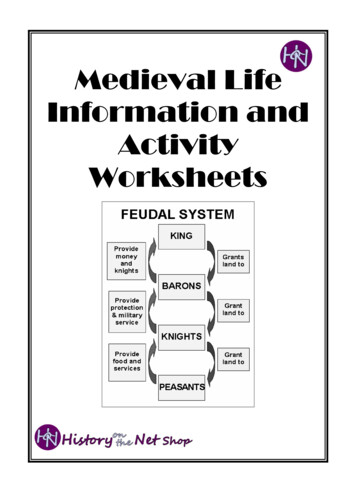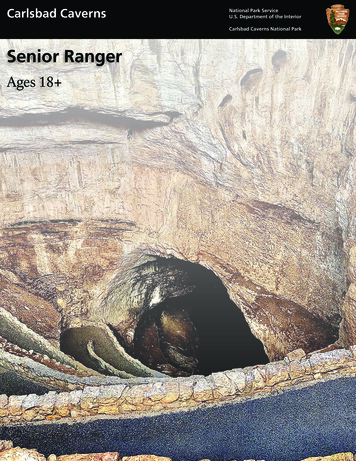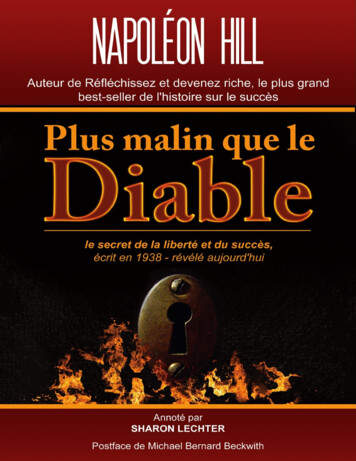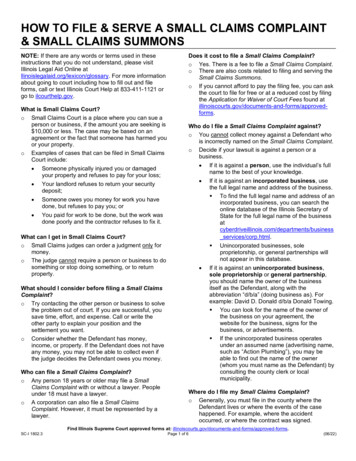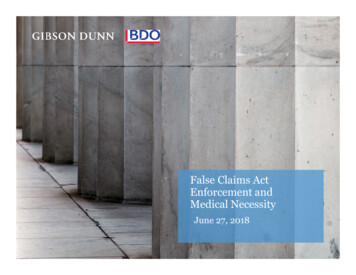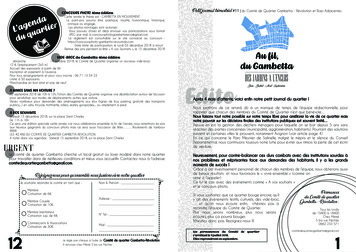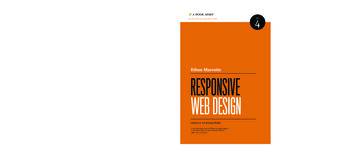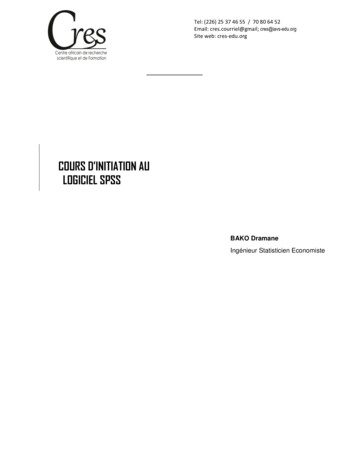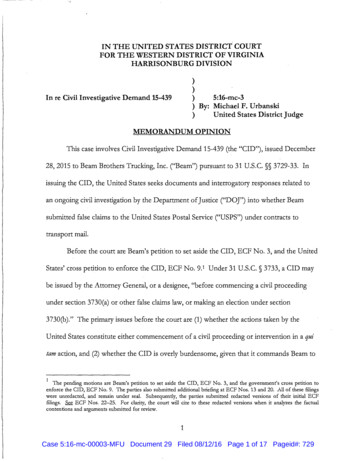
Transcription
IN THE UNITED STATES DISTRICT, COURTFOR THE WESTERN DISTRICT OF VIRGINIAHARRISONBURG DIVISION)))5:16-mc-3) By: Michael F. Urbanski)United States District JudgeIn re Civil Investigative Demand 15-439MEMORANDUM OPINIONThis case involves Civil Investigative Demand 15-439 (the "CID"), issued December28, 2015 to Beam Brothers Trucking, Inc. ("Beam") pursuant to 31 U.S.C. §§ 3729-33. Inissuing the CID, the United States seeks documents and interrogatory responses related toan ongoing civil investigation by the Department of Justice ("DOJ") into whether Beamsubmitted false claims to the United States Postal Service ("USPS") under contracts totransport mail.Before the court are Beam's petition to set aside the CID, ECF No. 3, and the UnitedStates' cross petition to enforce the CID, ECF No. 9. 1 Under 31 U.S.C. § 3733, aCID maybe issued by the Attorney General, or a designee, "before commencing a civil proceeding ·under section 3730(a) or other false claims law, or making an election under section3730(b)." The primary issues before the court are (1) whether the actions taken by theUnited States constitute either commencement of a civil proceeding or intervention in a quitam action, and (2) whether the CID is overly burdensome, given that it commands Beam to1The pending motions are Beam's petition to set aside the CID, ECF No. 3, and the government's cross petition toenforce the CID, ECF No.9. The parties also submitted additional briefing at ECF Nos. 13 and 20. All of these filingswere unredacted, and remain under seal. Subsequently, the parties submitted redacted versions of their initial ECFfilings. See ECF Nos. 22-25. For clarity, the court will cite to these redacted versions when it analyzes the factualcontentions and arguments submitted for review.1Case 5:16-mc-00003-MFU Document 29 Filed 08/12/16 Page 1 of 17 Pageid#: 729
produce a large quantity of materials already in the possession of the United States. Becausethe court finds that the United States has not commenced a civil proceeding or made anelection in regards to a qui tam action, Beam's motion to set aside the CID, ECF No.3, isDENIED.The court finds that DOJ-Civil has authority to issue the CID and that theinformation sought appears relevant to the investigation of Beam. At the same time,however, the government acknowledges that certain of the information requested in theCID is already in its possession by virtue of its six year investigation. Given this lengthygovernment investigation, during which the government has obtained a large volume ofBeam's data, the court is required to consider whether enforcement of the CID will beunduly burdensome in that it will require production of information already within thegovernment's possession. United States v. Powell, 379 U.S. 48, 57-58 (1964). Beam arguesthat many of the documents requested duplicate those obtained by the government bymeans of a search warrant and Beam's voluntary production. The government disputes theamount of duplication wrought by the CID, and posits that certain other non-duplicativeinformation is necessary. Unlike the parties, the court is in no position to assess the extentto which the CID would require duplicative production. As such, the court TAKESUNDER ADVISEMENT the government's motion to enforce the existing CID, ECF No.9, and DIRECTS the parties to meet and confer as to the production of non-duplicativeinformation relevant to the government's inquiries. Should the parties not be able tonegotiate the production of relevant, non-duplicative information within sixty (60) days, the2Case 5:16-mc-00003-MFU Document 29 Filed 08/12/16 Page 2 of 17 Pageid#: 730
government may renew its motion or issue an Amended CID narrowly tailored to obtainrelevant and non-duplicative information within ninety (90) days.I.Beam is a trucking company located in Mt. Crawford, Virginia, and its businessconsists primarily of shipping mail for the USPS. ECF No. 24, at 1. Beam contracts withthe USPS to deliver mail on a number of Highway Contract Routes ("HCR"). Id. at 3.Since 2005, Beam participated in the USPS's HCR Fuel Management Program("FMP"). Id. Beam indicates that prior to 2005, postal contractors like Beam incorporatedfuel cost estimates into their contract bids, subject to an adjustment for fuel pricefluctuations. I d. In the pre-2005 system, contractors were allowed to retain fuel money tothe extent the estimate exceeded actual use. Id. Beam indicates that since 2005, USPSrequired postal contractors to participate in the FMP program. Id. Under the FMP, USPSprovided contractors including Beam with Voyager fleet transaction cards, essentially creditcards, to purchase fuel for HCR routes. Id. Beam received a number ofVoyager cards touse for authorized fuel purchases. Id. FMP clauses contained in the HCR contractsgoverned the appropriate use of the Voyager cards. Id. In 2014, USPS began phasing outuse of the Voyager cards after determining that use of the cards was generally ineffective andthat USPS itself could not comply with requirements of the Voyager program. Id. at 4. Thegovernment indicates that while many HCR contracts provide fuel reimbursement throughuse of the Voyager card, some contracts stipulate pre-payment of fuel expenses based on amonthly quota that fluctuates with regional fuel price changes. ECF No. 22, at 3.3Case 5:16-mc-00003-MFU Document 29 Filed 08/12/16 Page 3 of 17 Pageid#: 731
The government has been investigating whether that Beam may have misused theVoyager cards by using them for fuel on non-USPS routes, for farm equipment, for personalvehicles, and on HCR contracts where Beam had already been reimbursed through analternative payment arrangement. Id. at 4. The government questions whether Beam hasmisuse the Voyager cards, leading to Beam's receipt of fuel reimbursements far in excess ofwhat was stipulated under contracts with the USPS. Id.On February 12, 2013, approximately thirty federal agents executed a search warranton Beam's Mt. Crawford, Virginia office, seizing large quantities of corporate records. ECFNo. 24, at 2. 2 In an affidavit in support of the application for the search warrant to beexecuted on Beam, a special agent with the United States Department of Transportation("USDOT") Office of the Inspector General ("OIG") stated that "[s]ince June of 2010,USDOT-OIG and the Postal Service-OIG have been engaged in this investigation." Aff. ofJoseph A. Harris, ECF No. 24-1, Ex. 3, 11.Following the raid, Beam engaged in discussions with various government agenciesregarding the investigation. ECF No. 24, at 2. On September 4, 2013, Beam personnel metwith government officials representing DOJ-Civil, DOJ-Criminal, and the U.S. Attorney'soffice for the Western District of Virginia. Id. Greg Pearson, an attorney with DOJ-Civiland the named custodian of the CID, attended the September 4, 2013 meeting. Id. Inaddition to the parallel civil and criminal investigations, Beam believes that a qui tam actionhas been filed against it in New Jersey. Id. at 4.2 The United States indicates that the search warrant was executed in relation to a related criminal investigation ofBeam. While DOJ-Civil has access to materials seized on February 12, 2013, DOJ-Civil has deferred to the criminalinvestigation and did not request documents or information from Beam until July 2015.4Case 5:16-mc-00003-MFU Document 29 Filed 08/12/16 Page 4 of 17 Pageid#: 732
Beam contends the government has decided to intervene in the qui tam action,rendering service of the CID improper. The government has not conflrmed the existence ofthe qui tam action, nor has the government flled a suit under 31 U.S.C. § 3730(a). ECF No.22, at 11. On July 29, 2015, Gregory Pearson, on behalf ofDOJ-Civil, sent a letter to Beamoutlining the government's "flndings regarding potential False Claims' Act . violations byBeam Bros. Trucking." July 29, 2015 Letter from Greg Pearson, ECF No. 24-1, Ex. 6. Thisletter relayed the United States' belief that Beam had improperly used Voyager cards andthereby obtained "money from the federal government to which it [was] not entitled, and[did] so with actual knowledge or recklessly." Id.Negotiations, including a settlement proposal prepared by the government, failed toresolve the concerns raised in the July 29 letter, and DOJ -Civil served the CID on Beam onDecember 28, 2015. ECF No. 22, at 5. The CID seeks production of documents andanswers to written interrogatories that relate to Beam's use ofVoyager cards, governmentcontracts, and fuel reimbursement.Beam asserts that in executing the February 12, 2013 search warrant, ·the governmentseized Beam contracts, driver gas receipts, flfty-flve boxes of fuel files, three boxes thatincluded fuel flles, and eight boxes of employee flies. ECF No. 25, at 6. The governmentalso imaged all of Beam's computers, which contained a number of documents pertaining tofuel. Id. Beam asserts that a number of other documents relating to fuel purchases havebeen voluntarily produced. Id.The government does not challenge that it possesses some documents responsive to-the CID, but disputes the extent of the duplication requested. ECF No. 22, at 10. Even5Case 5:16-mc-00003-MFU Document 29 Filed 08/12/16 Page 5 of 17 Pageid#: 733
were it, to consider Beam's concerns as to duplication to be true, the government asserts"that over half the materials requested by the CID have yet to be provided and should beprovided." Id.II.The False Claims Act ("FCA"), 31 U.S.C. §3729-33, empowers the Attorney General,or her designee, to issue aCID requesting documents, responses to interrogatories, ordeposition testimony. 31 U.S.C. § 3733(a)(1). The CID can only be issued "beforecommencing a civil proceeding under section 3730(a) or other false claims law, or making anelection under section 3730(b)." 31 U.S.C. § 3733(a)(1); United States v. Kernan Hosp., No.RDB-11-2961, 2012 WL 5879133, *3 (D. Md. Nov. 20, 2012). The CID allows thegovernment "to assess quickly, and at the least cost to the taxpayers or to the party fromwhom information is requested, whether grounds exist for initiating a false claims suit."United States v. Markwood, 48 F.3d 969, 979 (6th Cir. 1995).ACID is an administrative subpoena. Markwood, 48 F.3d at 975-76. Courts mustenforce an administrative subpoena where: (1) the issuing agency has authority to engage inthe investigation; (2) the issuing agency has complied with the statutory requirements of dueprocess; (3) the information sought is reasonably relevant to the investigation and (4) wherethe information sought is not unduly burdensome. E.E.O.C. v. Ranstad, 685 F.3d 433, 442(4th Cir. 2012); EEOC v. Maryland Cup Corp., 785 F.2d 471,476 (4th Cir. 1986); see alsoUnited States v. Powell, 379 U.S.48, 57-58 (1964); EEOC v. Ocean City Police Dept., 787F.2d 955, 957 (4th Cir. 1986); Marshall v. Stevens People & Friends for Freedom, 669 F.2d171, 176 (4th Cir. 1981)(dting United States v. Morton Salt Co., 338 U.S. 632,652 (1950)).6Case 5:16-mc-00003-MFU Document 29 Filed 08/12/16 Page 6 of 17 Pageid#: 734
III.The court will first address Beam's petition to set aside the CID and decide whetherthe United States has made an election under 31 U.S.C. § 3733(a)(1). Beam contends thatthe government has made an election, or a defado election, under 31 U.S.C. § 3733(a)(1),rendering the issuance of the CID improper. The government counters that no suchelection has been made and that the CID is enforceable. Because the courts finds that theactions taken by the United States do not amount to an election, DOJ-Civil is not barredfrom issuing aCID. As such, Beam's petition to set aside CID 15-439, ECF No.3, isDENIED.A.Beam urges the court to find the government has actually decided to intervene in aqui tam action or commence an FCA claim. ECF No. 24, at 6-10. Alternatively, Beamargues that the government's conduct amounts to a commencement of a de facto proceedingagainst Beam. Id. at 11-15. Beam points out that the length of the government'sinvestigation, the volume of information about Beam in the government's possession, andthe analysis and assessment necessary to formulate a settlement proposal compel theconclusion that the government has decided to intervene in the qui tam case. Beam arguesthat the CID is thus improper and will allow the government to gain a significant upperhand in litigation or leverage a more favorable settlement as Beam will have had noopportunity to engage in discovery before the government has accumulated all the materialsneeded to pursue a civil case.B.7Case 5:16-mc-00003-MFU Document 29 Filed 08/12/16 Page 7 of 17 Pageid#: 735
There is little guidance as to what constitutes "commencing a civil proceeding undersection 3730(a) or other false claims law, or making an election under section 3730(b)."Beam relies heavily on United States v. Kernan Hosp., No. RDB-11-2961, 2012 WL5879133, *3 (D. Md. Nov. 20, 2012), for the proposition that a federal case need not actuallybe pending for a court to find the government has made an election under§ 3733. InKernan, the United States alleged that defendant Kernan Hospital defrauded thegovernment by systematically "upcoding" treatments to increase Medicare, Medicaid, andTricare reimbursements. Id. at *1. The United States' complaint, flied in October 2011, wasdismissed in full for failure to adequately plead fraud. Id. After the dismissal of its initialcomplaint, the United States issued aCID requiring Kernan Hospital to submit documentsrelated to medical records, coding summaries, and e-mails. Id.'at *1-2. Kernan Hospitalmoved to set aside the CID, arguing that the United States had commenced a civilproceeding by filing a complaint. Id. at *2. The court ruled in favor of Kernan Hospital,reasoning that a suit need not actually be pending to bar the issuance of aCID. Id. at *5-7.The court explained that where the government engaged in discovery leading to the filing ofa lawsuit, the issuance of a CID-to determine whether a lawsuit should be brought in thefirst place-no longer served any purpose. Id. Because the United States had actually fliedsuit, an action was commenced for purposes of§ 3733 and the CID could serve no lawfulpurpose. I d. at 7.The court gave no credence to the United States' argument that the CID soughtinformation needed to amend the complaint and cure pleading deficiencies. Id. at 6. Thecourt explained that the government had ample opportunity to acquire such information8Case 5:16-mc-00003-MFU Document 29 Filed 08/12/16 Page 8 of 17 Pageid#: 736
during a lengthy three year investigation that involved review of over 19,000 documents anddeposition testimony pursuant to an earlier CID. Id. Indeed, the voluminous discoveryprovided enough evidence to merit filing a suit. In sum, Kernan teaches that the filing of asuit-regardless of whether that suit is pending at the time a CID is issued-bars thegovernment from thereafter issuing aCID.Though the government has similarly engaged in a lengthy investigatr n related topotential claims against Beam, Kernan does not reach the issue presented to this court:whether an extensive investigation and a settlement offer amount to the commencement ofan FCA action or an election as to a qui tam action. Assuming Beam is correct in assertingthat a qui tam action has been filed, that filing in itself does not bar the government'sissuance of aCID. Avco Corp. v. U.S. Dep't of Justice, 884 F.2d 621, 627 (D.C. Cit. 1989).c.Beam presents a compelling argument that after a more than a six year investigation,during which time the government has amassed a large quantity of information throughsearch warrants that included imaging of Beam computers, voluntary production ofdocuments, and interviews with many Beam employees, the government should have ampleinformation to determine whether to intervene in a qui tam action. Based largely upondecisions by courts declining to extend the government's time to review and evaluate qui tamcases prior to unsealing and service, Beam argues that the length and scope of thegovernment's investigation, combined with the analysis necessary to formulate a settlementoffer, indicate the United States, in fact, has made an election to intervene in the qui tam caseagainst Beam.9Case 5:16-mc-00003-MFU Document 29 Filed 08/12/16 Page 9 of 17 Pageid#: 737
For example, in United States ex rel. Costa v. Baker & Taylor, 955 F. Supp. 1188(N.D. Cal. 1997), the court denied the government's motion for a fourth extension to thesealing period in a qui tam case and compelled the government to make an election as tointervention. The court remarked that "[i]n this case, the government appears to be fullyengaged in its discovery, without giving the defendants the opportunity even to answer thecomplaint." Id. at 1190. The court found the government's arguments as to theramifications of lifting the seal on settlement discussions and related criminal caseunpersuasive, pointing out that the government already had time far in excess of the 60-daysealing period envisioned by Congress to make its intervention decision.The opinion of the court in U.S. ex rel. Martin v. Life Care Center of America, Inc.,912 F. Supp. 2d 618 (E.D. Tenn. 2012), was likewise critical of unduly extending the sealingperiod for unserved qui tam actions. The court stated "[i]t defies logic to suggest that thegovernment would give defendant a 'lengthy and detailed' report of an investigation andattempt to obtain a settlement based on claims that it did not intend to pursue." Id. at 624.The Fourth Circuit Court of Appeals has expressed concern with the frequency andlack of scrutiny with which district courts extend sealing periods in qui tam cases,emphasizing that courts must "weigh carefully any such extension beyond the 60-day[sealing] period." ACLU v. Holder, 673 F.3d 245, 257 (4th Cir. 2011). The Fourth Circuithas also upheld the quashing of a grand jury subpoena where the district court found the"government sought the [grand jury] subpoena solely for the purpose of obtaining discoveryfor the civil [qui tam] proceeding." In re Grand Jury Subpoena, 175 F.3d 332, 340 (4th Cir.1999).10Case 5:16-mc-00003-MFU Document 29 Filed 08/12/16 Page 10 of 17 Pageid#: 738
Despite the tenor of these cases, they do not directly support Beam's argument thatthe government has intervened in a qui tam action for purposes of 31 U.S.C. § 3733. Thus,the length and depth of the government's investigation-though often dispositive inopinions considering ex parte motions to extend qui tam seals-play a less significant role inascertaining whether United States has elected to intervene in a qui tam action.D.As noted above,§ 3733 precludes the issuance of aCID where the governmentcommences a civil FCA action pursuant to§ 3730(a) or other false claims law or makes anelection under section§ 3730(b). Here, the United States has flied no claim against Beampursuant to the FCA or any other false claim law. Thus, DOJ -Civil is only precluded fromissuing the CID if the United States' actions amount to a decision to intervene in a qui tamaction. 3In ACLU v. Holder, the Fourth Circuit Court of Appeals explained the process bywhich the United States accepts or declines intervention in a qui tam action:If the United States intervenes, it notifies the coUrt and the quitam relator, and the United States takes over the litigation.Following intervention, the complaint is unsealed, the docket isunsealed, and the United States serves the complaint on the·defendant pursuant to Rule 4 of the Federal Rules of CivilProcedure. At that point, the United States may amend thecomplaint, move to dismiss the action or certain claims, seek tosettle the action, pursue the claims through alternative remedies,or litigate the action. See 31 U.S.C. §§ 3730(b)(1), 3730(c)(2)(A)(discussing dismissal); id. § 3730(c)(2)(B) (discussing settlement);id. § 3730(c)(5) (discussing alternative administrative false claimsremedies)3Again, the court notes that while Beam provides good reason to suspect a qui tam action has been @ed, the existenceof such case is unconfirmed.11Case 5:16-mc-00003-MFU Document 29 Filed 08/12/16 Page 11 of 17 Pageid#: 739
If the United States declines to intervene, it notifies the courtand the qui tam relator. The complaint is then unsealed, thedocket is unsealed, and the qui tam relator serves the complainton the defendant pursuant to Rule 4 of the Federal Rules ofCivil Procedure. The qui tam relator then litigates the caseagainst the defendant.673 F.3d at 250-51. As this case makes clear, the government's election to interveneinvolves formal steps that result in the unsealing of the qui tam action, service upon thedefendant, and litigation with or without the United States taking part. In the present case,neither the complaint nor docket for the putative qui tam action has been unsealed, nor hasBeam been served with a complaint. Thus, under the Fourth Circuit's description of anintervention election, the United States has not intervened in a qui tam action.Beam asserted at oral argument that had it accepted the United States' settlementoffer, a qui tam relator would have been entitled to a portion of the settlement proceeds.Indeed, under 31 U.S.C. § 3730(c)(5), the relator is entitled to proceeds where the UnitedStates settles prior to making an intervention election. Such a settlement is a preintervention alternate remedy. See U.S. ex rel. Bledsoe v. Community Health System, Inc.,342 F. 3d 634, 649 (6th Cir. 2003) ("[A] settlement pursued by the government in lieu ofintervening in a qui tam action asserting the same FCA claims constitutes an alternate remedyfor purposes of 31 U.S.C. § 3730(c)(5).") Thus, under Bledsoe and§ 3730(c)(5), preintervention settlement effectively amounts to an election not to intervene in which therelator is entitled to proceeds and the United States is precluded from further pursuing thequi tam action. In the present case, no settlement between the United States and Beam hasbeen reached. Therefore, the court need not consider the ramifications of an actualsettlement between Beam and the United States. It is undisputed that the United States12Case 5:16-mc-00003-MFU Document 29 Filed 08/12/16 Page 12 of 17 Pageid#: 740
retains the rights to intervene in any sealed qui tam action and no relator is yet entitled toproceeds.E.Beam may well have good reason to believe that it may soon face a qui tam action.However, this court, like Beam, has no way of confirming the existence or status of a sealedqui tam action pending in a different district. The facts before the court reveal that thegovernment has not filed an FCA claim; no qui tam action has been unsealed or served, andthe government has taken no action that would foreclose its right to intervene in a qui tamaction. Therefore under 31 U.S.C. § 3733(a), DOJ-Civil has taken no action that bars thefiling of CID 15-439. Accordingly, Beam's Petition to Set Aside CID No. 15-439, ECF No.3, is DENIED.IV.Having denied Beam's motion to set aside the CID, the court now considers thegovernment's cross-petition to enforce CID pursuant to 31 U.S.C. § 37330). ECF No.9.As noted above, aCID is an administrative subpoena enforceable when (1) the issuingagency has authority to engage in the investigation; (2) the issuing agency has complied withthe statutory requirements of due process; (3) the information sought is reasonably relevantto the investigation; and (4) where the information sought is not unduly burdensome.E.E.O.C. v. Ranstad, 685 F.3d 433, 443 (4th Cir. 2012).Beam does not dispute that DOJ-Civil is an agency with authority to issue the CID.DOJ-Civil, acting on behalf of the Attorney General, plainly possesses authority to13Case 5:16-mc-00003-MFU Document 29 Filed 08/12/16 Page 13 of 17 Pageid#: 741
investigate potential FCA violations. As noted above, 31 U.S.C. § 3733 does not precludethe filing of aCID in the present case. Therefore the flrst and second prongs are met.Nor does Beam argue that the CID requests information that is irrelevant to thegovernment's investigation into Beam's use of the Voyager cards. As the government notes,as long as the materials requested "[t]ouch a matter under investigation," an administrativesubpoena will survive a challenge that the material is not relevant. Sandsend FinancialConsultants Ltd. v. Federal Home Bank Bd., 878 F.2d 875, 882 (5th Cir. 1989). DOJ'sdetermination is accepted so long as it is not obviously wrong. NLRB v. American MedicalResponse, Inc., 438 F.3d 188, 193 (2nd Cir. 2006). The CID seeks documents that relate toBeam's use ofVoyager cards, HCR contracts, fuel adjustment prices, non-FMP USPScontracts,Beam scompliance and opinion as to appropriate use of Voyager cards, poolingof fuel purchases, fuel used in relation to Voyager contracts, and documents to supportother responses to the United States inquiries. CID 15-439, ECF No. 24-1, Ex. 4. Thus,the requested documents appear relevant to the government's investigation. The third prongis met.As to the fourth prong, Beam maintains the burden of showing the subpoena isunduly burdensome or unreasonably broad. F.T.C. v. Texaco, Inc., 555 F.2d 862, 882 (D.C.Cir. 1977). "Some burden on subpoenaed parties is to be expected and is necessary infurtherance of the agency's legitimate inquiry and the public interest." Id. The FourthCircuit Court of Appeals has explained that "[t]he burden of proving that an administrativesubpoena is unduly burdensome in not easily met. The party subject to the subpoena mustshow that producing the documents would seriously disrupt its normal business operations."14Case 5:16-mc-00003-MFU Document 29 Filed 08/12/16 Page 14 of 17 Pageid#: 742
N.L.R.B. v. Carolina Food Processors, Inc., 81 F.3d 507, 513 (4th Cir. 1996)(quoting EEOCv. Maryland Cup Corp., 785 F.2d 471, 477 (4th Cir. 1986)). However, "the district court isauthorized to impose reasonable conditions and restrictions with respect to the productionof the subpoenaed material if the demand is unduly burdensome." Texaco, Inc., 555 F.2d at881.In considering whether administrative subpoenas are properly issued, the UnitedStates Supreme Court requires "that the information sought is not already within the[agency's] possession." United States v. Powell, 379 U.S. 48, 57-58 (1964). Similarly, theSixth Circuit Court of Appeals' test for analyzing administrative subpoenas issued by DO]expressly requires that "the information sought is not already in the DOJ's possession."Doe v. United States, 253 F.3d 256, 265 (6th Cir. 2001). Though not explicitly addressed inthe Fourth Circuit's test for administrative subpoenas, concerns as to duplicative productionand DOJ-Civil seeking information already within its possession threaten an undue burdenupon the subpoenaed party.Though the government suggests that Beam overstates the extent to which thegovernment already has taken or received documents responsive to the CID, thegovernment, both in their brief and at oral argument, does not dispute that it alreadypossesses many of the documents requested in the CID. This is particularly true, given thatover the course of a six year investigation, the government has seized dozens of boxes ofdocuments containing fuel and employee flies, imaged Beam's computer hard drives, andreceived many other relevant documents through voluntary production. ECF No. 25, at 6.15Case 5:16-mc-00003-MFU Document 29 Filed 08/12/16 Page 15 of 17 Pageid#: 743
Beam argues, and the court agrees, that the government's CID must be considered inthe context of the lengthy and wide-ranging investigation that has already transpired. Giventhe scope of the government's investigation, the vast amount of information already in thegovernment's possession by virtue of the search warrant and voluntary production, and thebreadth of the pending CID, it may well be that it would be unduly burdensome for Beam tocomply chapter and verse with the myriad specifications of the CID. As such, the court willtake the government's request to enforce the CID, ECF No.9, under advisement for sixty(60) days during which the parties are directed to meet and confer on categories of relevant,non-duplicative documents to be produced. Should such efforts fail, the government mayrenew its motion or issue an Amended CID narrowly tailored to obtain relevant and nonduplicative information within ninety (90) days.v.Because the govvrnment has not commenced a civil proceeding under section 3730(a)or other false claims law, or made an election under section 3730(b), Beam's motion to setaside the CID, ECF No. 3, is DENIED. Though the court finds that DOJ-Civil has theauthority to issue the CID and that the requested material appears relevant, the court hasreservations requiring Beam to comply with a CID seeking the production of documents,many of which are already within the possession of the United States. Therefore, thegovernment's motion to enforce the CID, ECF No.9, is TAKEN UNDERADVISEMENT for sixty (60) days during which the parties are directed to meet andconfer regarding production of categories of relevant and non-duplicative information.16Case 5:16-mc-00003-MFU Document 29 Filed 08/12/16 Page 16 of 17 Pageid#: 744
Should such efforts fail, the government may renew its motion or issue an Amended CIDnarrowly tailored to obtain relevant and non-duplicative information within ninety (90) days.Entered:ag-I; . - 2-DI ';,;pr f. 'lh Michael F. UrbanskiUnited States District Judge17Case 5:16-mc-00003-MFU Document 29 Filed 08/12/16 Page 17 of 17 Pageid#: 745
This case involves Civil Investigative Demand 15-439 (the "CID"), issued December 28, 2015 to Beam Brothers Trucking, Inc. ("Beam") pursuant to 31 U.S.C. §§ 3729-33. In issuing the CID, the United States seeks documents and interrogatory responses related to an ongoing civil investigation by the Department of Justice ("DOJ") into whether Beam
